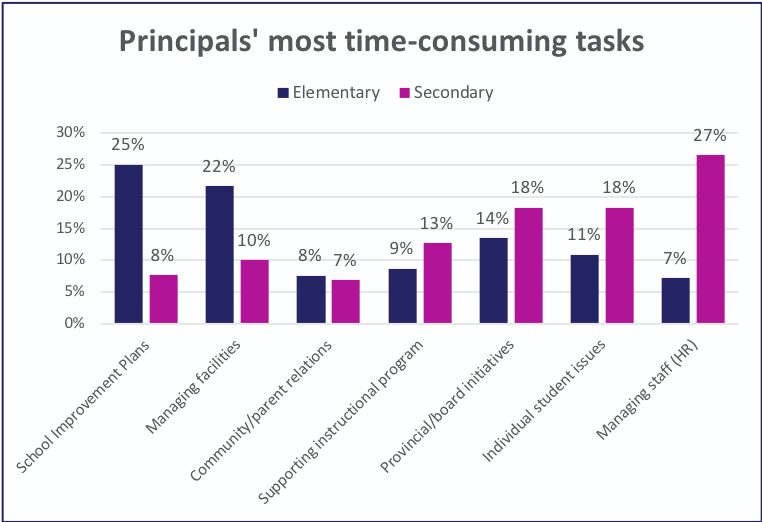Report finds increased demands on Ontario principals
Data from People for Education, based on survey results from 1244 schools across Ontario, show that principals are experiencing competing demands – leaving them with less time to fulfill their role as curriculum leaders.
In their responses to People for Education’s Annual Ontario School Survey, 22% of elementary school principals and 10% of secondary principals reported that managing facilities is the most time-consuming part of their job. In comparison, only 9% of elementary and 13% of secondary principals ranked supporting professional learning and improving the instructional program as the task they spend the most time on.

One principal commented, “There are way too many managerial and day-to-day running-of-the-school tasks, so that professional learning and instructional programming is left to the last, done superficially, and not as well as it could be.”
Principals a key influence on student learning
According to the report, principals are second only to teachers in terms of school-related factors that have an impact on student learning. Principals lead school improvement initiatives, attend to individual student needs, and support the implementation of Ministry and school board initiatives. Recent research from Western University found that principals in Ontario work an average of 59 hours per week and vice-principals work an average of 55 hours.
Principals raise concerns about students’ mental health
In their survey responses, many principals identified students’ mental health as an urgent issue. They reported that existing mental health resources such as social workers, psychologists, and guidance counsellors, were insufficient to meet students’ needs, and that mental health issues were taking up an increasing amount of their time and resources.
According to one GTA principal, “It is very challenging to balance the principal role. The needs of our students are becoming increasingly complex. Mental health issues have been more prominent in our day-to-day dealings, with minimal support and limited expertise in the building.”
Vice-principals make a difference
Vice-principals play a central role in a school’s leadership team. The vice-principal works with the principal in leading and managing the school, and is often responsible for managing student discipline issues and special education. Data from the report show that:
- 21% of elementary schools have a full-time vice-principal and 25% have a part-time vice-principal
- Only 39% of rural elementary schools report a vice-principal, compared to 50% of urban schools.
- 85% of secondary schools have at least one full-time vice-principal and 8% have one part-time.
According to the survey findings, elementary schools with at least one full-time vice-principal are more likely to report that the principal spends the most time improving the instructional program and completing the School Improvement Plan.
“People for Education’s annual report underscores the feedback we continue to receive from our 2,100 Catholic Principals and Vice-Principals. The evolving roles of Principals and Vice-Principals have resulted in an alarming increase in workload. Our school leaders, at both the elementary and secondary levels, are spending a disproportionate amount of time handling administrative tasks rather than improving student learning. We’re thankful for the opportunity to contribute to this very important survey and report, and optimistic to continue to dialogue with key provincial decision makers and partners to ensure that ‘principals can focus more of their time on student learning and staff development’.” – Jennifer Yust, President, Catholic Principals’ Council of Ontario
Report recommends change
The report recommends that the province work with principals’ organizations to identify where more supports are required and how demands on principals’ time can be alleviated, so that they can focus more on student learning and staff development.
Survey unique in Canada
People for Education’s Annual Ontario School Survey is unique in Canada. Every October, for the last 21 years, the survey is sent to every one of Ontario’s 4,900 publicly funded schools – providing data and information about resources and programs that are vital for students long-term success. We use the data gathered to provide reports to the public, policy-makers, the media and education stakeholders, and to lead the public dialogue about the value and future of public education in Canada.
